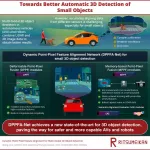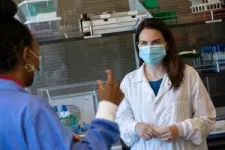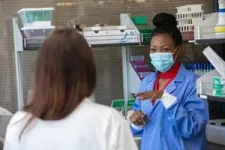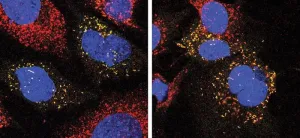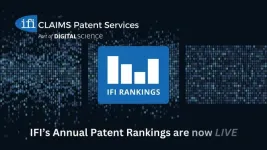(Press-News.org)
Robotics and autonomous vehicles are among the most rapidly growing domains in the technological landscape, with the potential to make work and transportation safer and more efficient. Since both robots and self-driving cars need to accurately perceive their surroundings, 3D object detection methods are an active area of study. Most 3D object detection methods employ LiDAR sensors to create 3D point clouds of their environment. Simply put, LiDAR sensors use laser beams to rapidly scan and measure the distances of objects and surfaces around the source. However, using LiDAR data alone can lead to errors due to the high sensitivity of LiDAR to noise, especially in adverse weather conditions like during rainfall.
To tackle this issue, scientists have developed multi-modal 3D object detection methods that combine 3D LiDAR data with 2D RGB images taken by standard cameras. While the fusion of 2D images and 3D LiDAR data leads to more accurate 3D detection results, it still faces its own set of challenges, with accurate detection of small objects remaining difficult. The problem mainly lies in properly aligning the semantic information extracted independently from the 2D and 3D datasets, which is hard due to issues such as imprecise calibration or occlusion.
Against this backdrop, a research team led by Professor Hiroyuki Tomiyama from Ritsumeikan University, Japan, has developed an innovative approach to make multi-modal 3D object detection more accurate and robust. The proposed scheme, called “Dynamic Point-Pixel Feature Alignment Network” (DPPFA−Net), is described in their paper published in IEEE Internet of Things Journal on 3 November 2023.
The model comprises an arrangement of multiple instances of three novel modules: the Memory-based Point-Pixel Fusion (MPPF) module, the Deformable Point-Pixel Fusion (DPPF) module, and the Semantic Alignment Evaluator (SAE) module. The MPPF module is tasked with performing explicit interactions between intra-modal features (2D with 2D and 3D with 3D) and cross-modal features (2D with 3D). The use of the 2D image as a memory bank reduces the difficulty in network learning and makes the system more robust against noise in 3D point clouds. Moreover, it promotes the use of more comprehensive and discriminative features.
In contrast, the DPPF module performs interactions only at pixels in key positions, which are determined via a smart sampling strategy. This allows for feature fusion in high resolutions at a low computational complexity. Finally, the SAE module helps ensure semantic alignment between both data representations during the fusion process, which mitigates the issue of feature ambiguity.
The researchers tested DPPFA−Net by comparing it to the top performers for the widely used KITTI Vision Benchmark. Notably, the proposed network achieved average precision improvements as high as 7.18% under different noise conditions. To further test the capabilities of their model, the team created a new noisy dataset by introducing artificial multi-modal noise in the form of rainfall to the KITTI dataset. The results show that the proposed network performed better than existing models not only in the face of severe occlusions but also under various levels of adverse weather conditions. “Our extensive experiments on the KITTI dataset and challenging multi-modal noisy cases reveal that DPPFA-Net reaches a new state-of-the-art,” remarks Prof. Tomiyama.
Notably, there are various ways in which accurate 3D object detection methods could improve our lives. Self-driving cars, which rely on such techniques, have the potential to reduce accidents and improve traffic flow and safety. Furthermore, the implications in the field of robotics should not be understated. “Our study could facilitate a better understanding and adaptation of robots to their working environments, allowing a more precise perception of small targets,” explains Prof. Tomiyama. “Such advancements will help improve the capabilities of robots in various applications.” Another use for 3D object detection networks is the pre-labeling of raw data for deep-learning perception systems. This would greatly reduce the cost of manual annotation, accelerating developments in the field.
Overall, this study is a step in the right direction towards making autonomous systems more perceptive and assisting us better with human activities.
***
Reference
DOI: https://doi.org/10.1109/JIOT.2023.3329884
About Ritsumeikan University, Japan
Ritsumeikan University is one of the most prestigious private universities in Japan. Its main campus is in Kyoto, where inspiring settings await researchers. With an unwavering objective to generate social symbiotic values and emergent talents, it aims to emerge as a next-generation research university. It will enhance researcher potential by providing support best suited to the needs of young and leading researchers, according to their career stage. Ritsumeikan University also endeavors to build a global research network as a “knowledge node” and disseminate achievements internationally, thereby contributing to the resolution of social/humanistic issues through interdisciplinary research and social implementation.
Website: http://en.ritsumei.ac.jp/
Ritsumeikan University Research Report: https://www.ritsumei.ac.jp/research/radiant/eng/
About Professor Hiroyuki Tomiyama from Ritsumeikan University, Japan
Professor Hiroyuki Tomiyama received B.E., M.E., and D.E. degrees in computer science from Kyushu University in 1994, 1996, and 1999, respectively. He joined the College of Science and Engineering at Ritsumeikan University in 2010, where he works as a Full Professor. He specializes in embedded and cyber-physical systems, autonomous drones, biochip synthesis, and the automation and optimization of electronic designs. He has published over 110 papers on these subjects as well as several books.
Funding information
This work is partly supported by JSPS KAKENHI Grant Number 20K23333 and partly commissioned by NEDO (Project Number JPNP22006).
END
Levi Gadye, 628-399-1046
Levi.Gadye@ucsf.edu | @UCSF
Video: https://ucsf.app.box.com/s/i3atd54ye4m1z1spi0qf59axq7tq7640
Subscribe to UCSF News
A high-sugar diet is bad news for humans, leading to diabetes, obesity and even cancer. Yet fruit bats survive and even thrive by eating up to twice their body weight in sugary fruit every day.
Now, UC San Francisco scientists have discovered how fruit bats may have evolved to consume so much sugar, with potential implications for the 37 million Americans with diabetes. The findings, published on Tuesday, Jan. 9, 2024 in Nature Communications, point to adaptations ...
HOUSTON ― A vaccine showed potential to prevent relapse of KRAS-mutated pancreatic and colorectal cancers for patients who had previously undergone surgery, according to a Phase I trial led by researchers at The University of Texas MD Anderson Cancer Center. Results were published today in Nature Medicine.
In the trial, patients with pancreatic and colorectal cancer who were considered at high risk of relapse received a maximum of 10 doses of the ELI-002 vaccine targeted toward KRAS G12D and G12R mutations. T cell responses were seen in 84% of all patients and in 100% of those in the two highest dose cohorts, including those who ...
International research led by the Translational Synthetic Biology Laboratory of the Department of Medicine and Life Sciences (MELIS) at Pompeu Fabra University has succeeded in efficiently engineering Cutibacterium acnes -a type of skin bacterium- to produce and secrete a therapeutic molecule suitable for treating acne symptoms. The engineered bacterium has been validated in skin cell lines and its delivery has been validated in mice. This finding opens the door to broadening the way for engineering non-tractable bacteria to address skin alterations and other diseases using living therapeutics.
The research team is completed by scientists from the Bellvitge Biomedical Research ...
As the potter works the spinning wheel, the friction between their hands and the soft clay helps them shape it into all kinds of forms and creations. In a fascinating parallel, sea squirt oocytes (immature egg cells) harness friction within various compartments in their interior to undergo developmental changes after conception. A study from the Heisenberg group at the Institute of Science and Technology Austria (ISTA), published in Nature Physics, now describes how this works.
The sea is full of fascinating life forms. From algae and colorful fish to marine snails and sea squirts, a completely different world reveals itself underwater. Sea squirts or ascidians in particular are very unusual: ...
Dutch scientists have discovered five biological variants of Alzheimer's disease, which may require different treatment. As a result, previously tested drugs may incorrectly appear to be ineffective or only minimally effective. This is the conclusion of researcher Betty Tijms and colleagues from Alzheimer Center Amsterdam, Amsterdam UMC and Maastricht University. The research results will be published on 9 January in Nature Aging.
In those with Alzheimer's disease, the amyloid and tau protein clump in the brain. In addition to these clumps, other biological processes such as inflammation and nerve ...
Luxembourg, 9 January 2024 – In a new position paper, and following engagement with its national members and the European Working Group of People with Dementia (EWGPWD), Alzheimer Europe calls for concrete actions to enable timely, safe and equitable access to anti-amyloid drugs, for patients who are most likely to benefit from these innovative new treatments for Alzheimer’s disease (AD).
The growing prevalence and impact of AD has catalysed huge investments in research on its causes, diagnosis, treatment and care. After many high-profile ...
For the first time, a research team at The Hospital for Sick Children (SickKids) has uncovered a way to potentially reduce the amount of toxic cellular waste accumulating in patients with Zellweger Spectrum Disorder (ZSD).
ZSD is a group of rare, neurodegenerative genetic conditions caused by genetic variations that reduce the number of peroxisomes – the parts of cells that are responsible for, among other tasks, breaking down fats. ZSD varies in severity and is characterized by progressive neurodegeneration as well as symptoms that range from visual impairments, such as cataracts, to liver and kidney disfunction.
Like all living ...
A study published today in IOP Publishing’s journal Environmental Research: Infrastructure and Sustainability has found that green ammonia could be used to fulfil the fuel demands of over 60% of global shipping by targeting just the top 10 regional fuel ports. Researchers at the University of Oxford looked at the production costs of ammonia which are similar to very low sulphur fuels, and concluded that the fuel could be a viable option to help decarbonise international shipping by 2050.
Around USD 2 trillion will be needed to transition to a green ammonia fuel supply chain by 2050, primarily to finance ...
New Haven, Conn., Jan. 9, 2024—U.S. patent grants declined 3.4% from 2022, the lowest level since 2019, and Samsung held onto the top spot for the second year in a row according to IFI CLAIMS Patent Services, world leader in tracking patent application and grant data.
IFI CLAIMS Patent Services is a Digital Science company that compiles and tracks data from the U.S. Patent and Trademark Office (USPTO) and other patent-issuing agencies around the globe. IFI translates its world-leading data into an annual U.S. Top 50 and IFI Global 250 patent rankings, providing valuable insights into companies’ R&D activity.
Other findings in IFI’s latest rankings include patent powerhouse ...
A combination of only 11 proteins can predict long-term disability outcomes in multiple sclerosis (MS) for different individuals. The identified proteins could be used to tailor treatments to the individual based on the expected severity of the disease. The study, led by researchers at Linköping University in Sweden, has been published in the journal Nature Communications.
“A combination of 11 proteins predicted both short and long-term disease activity and disability outcomes. We also concluded that it’s important to measure ...
